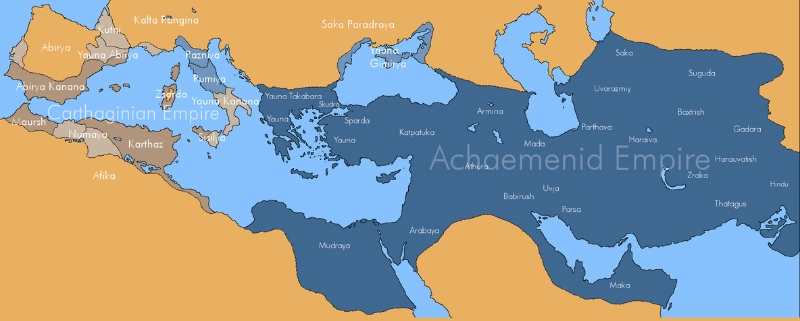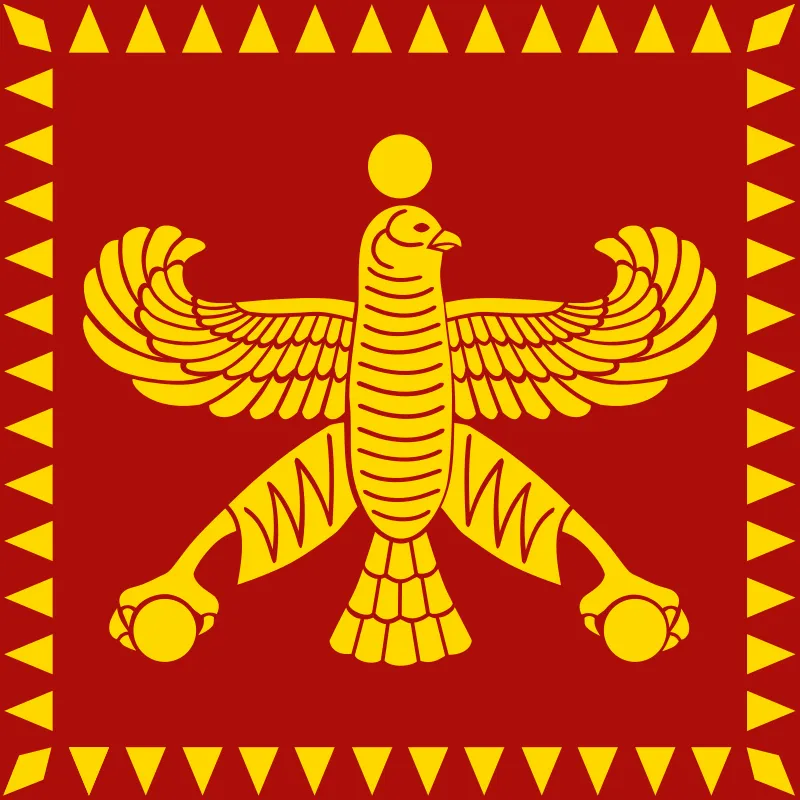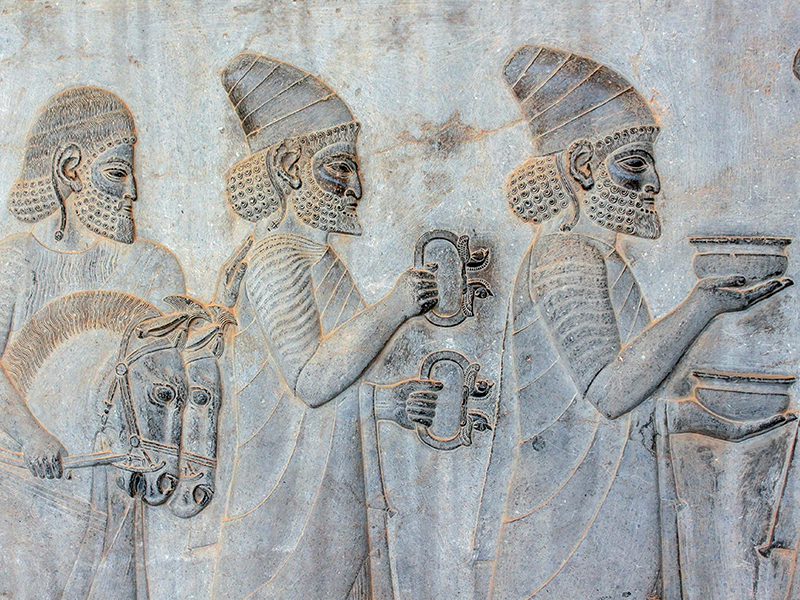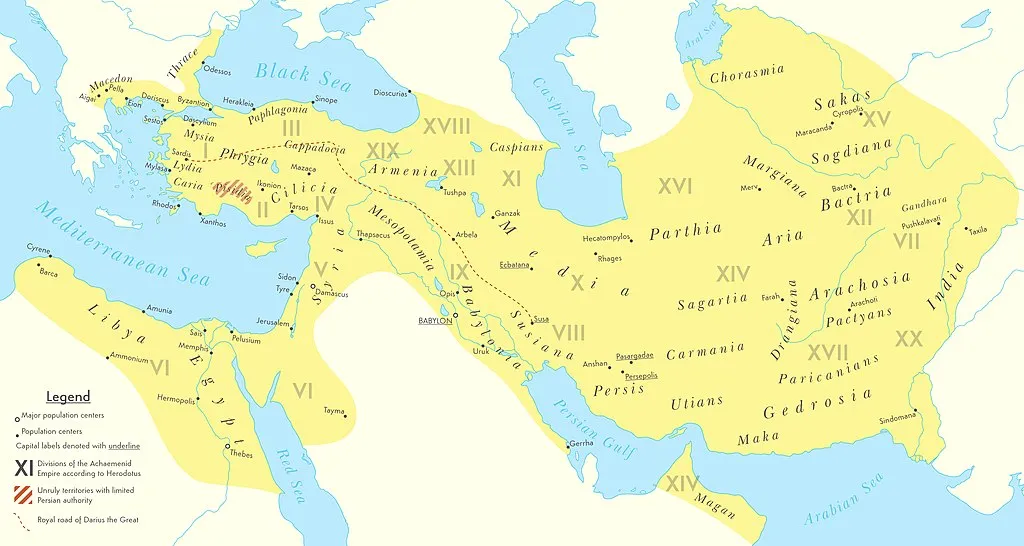Achaemenid Empire (Map, Flag, Pronunciation, Facts)
The Achaemenid Empire was one of the ancient Iranian dynasties before Islam and belonged to the Parsa dynasty. They traced their lineage to Achaemenid and named their dynasty after him. Although the Achaemenids were ruled by other kings before Cyrus the Great, Cyrus the Great is considered the founder of the Achaemenid dynasty due to Cyrus’s defeat of the Medes and the conquest of Lydia and Babylon, which turned the Achaemenid dynasty into a vast empire. Join us in this article to learn more about the magnificent Achaemenid Empire.
Cyrus the Great
Cyrus the Great, also known as Cyrus II, founder of the Achaemenid dynasty and commonly referred to as Cyrus the Great, ascended the throne in 550 BC, succeeding his father Cambyses I. He united various tribes under his rule. Although the Assyrians had not been able to eliminate Cyrus during his childhood, but when the uprising became clear, he was summoned to the court.
Cyrus refused and caused the Assyrians to declare war against him. The army of the Medes, who were dissatisfied with the cruelty of their king, joined the forces of Cyrus. Cyrus easily defeated the Median king and captured Ecbatana.
After ruling for eleven years, Cyrus also conquered Babylon in 546 BC. He founded Pasargad in the same year and established it as the capital of the Persian Achaemenid Empire. By the time of his death, Cyrus had extended the Achaemenid Empire to the farthest reaches of the known world.
As a wise and great ruler, Cyrus respected different cultures and used innovative methods of governance that enhanced the longevity of his empire.
Cambyses
After Cyrus, Cambyses came to power. Cambyses proved to be a capable ruler and conquered Egypt during his reign. However, the most significant event during this period was the mysterious death of Cambyses, which destabilized his political reign. Due to the suspicious circumstances of Cambyses’s death, which some considered to be a form of suicide, a dispute arose between him and the possible heirs to the throne. Finally, Darius the Great came to the throne from another branch of the Achaemenid dynasty.
Darius
Darius is often considered the greatest Achaemenid king. During his reign, he made many reforms and suppressed many uprisings. He expanded the borders of the Achaemenid Empire to the West and East and clashed with the Scythians in southern Russia.
The greatness of his achievements can be seen in the famous Behistun Inscription. He sought to solidify his political control in the West by conquering India. The war between Persia and Greece began during the reign of Darius and reached its peak with the defeat of the Persian Empire by the Greeks in 475 BC.
The first of these wars, known as the Battle of Marathon, ended without results, and Darius passed away before it ended.
Xerxes
After Darius, Xerxes came to power. Xerxes followed the war between Iran and Greece. In the summer of 479 BC, after suffering three consecutive defeats in the battles of Salamis, Plataea, and Mycale, he was forced to retreat from Asia Minor. During this period, there was a rebellion in Babylon, and Xerxes decided to deal with it. But he also failed in Babylon. It is noteworthy that Xerxes did not mention any of these events in his inscriptions, while the Greek sources exaggerated these defeats.
A close examination of the historical sources shows that Xerxes’ defeats in Greece and Babylon dealt a significant blow to the structure of his empire. It was after these defeats that the Greeks began to overthrow the Iranian satrapies in Anatolia, which resulted in the penetration of Greek culture in these regions. Xerxes was killed in a court conspiracy in 465 BC.
The Peak of Achaemenid Political Power
The peak of Achaemenid power was during the time of Darius the Great. Darius was a pragmatic and far-sighted ruler with a strong will and determination. He carefully selected government officials, military commanders, and other administrators and showed great sensitivity in this field.
Darius reformed the Achaemenid imperial system and created new organizational structures. During his time, the Achaemenid Empire experienced its greatest extent. But due to the incompetence of his successors, his efforts were fruitless after that.
Darius revised the laws of the empire and laid the foundation for new regulations to maintain peace within the country. He imposed a fair tax on estates and properties and ordered landowners to pay taxes based on the volume of their produce. In addition, Darius ensured the safety of the roads and improved and repaired the highways.
The royal road of the Achaemenid Empire connecting Sardis with Susa was built by Darius. The road stretched for 2,500 km and had more than 100 caravanserais along its route, each approximately 25 km apart. The construction of this royal road and the establishment of these caravanserais are evidence of Dariush’s power in the administration and development of the country.
Other Important Actions of Darius
The minting of gold coins by Darius shows the economic power of the Achaemenid Empire during his reign. Dariush built the Suez Canal to connect the Mediterranean Sea to the Red Sea to ensure Iran’s economic stability and facilitate economic relations with other countries, as well as the smooth passage of commercial ships.
Darius organized his vast political territory by dividing it into 22 satrapies. He began to gather forces to organize the army and provide manpower. In this regard, Dariush used the military and security forces and established the “Javidan,” an elite force. The Javidan of Darius had a population of 10,000, of which 4,000 were cavalry, who were responsible for protecting the royal palace.
Darius established a network of couriers throughout the empire, gathering news from every corner and bringing it quickly to the center of the empire. These couriers handled highly classified and confidential information with great care.
Achaemenid Empire Flag
Historical studies and archaeological evidence show that before the reign of Cyrus the Great, the symbol drawn on the Iranian flag was the symbol of a winged cow. This ancient symbol, known as “Derafsha,” is known as the first flag of Iran. With the emergence of the reign of Cyrus the Great, the image on the flag was transformed and replaced by the image of a bird of prey. Some historians know this bird as “Shahbaz,” a legendary bird that is mentioned in mythology as the savior of the Aryans and their guide to the land of Iran.
Achaemenid Meaning
The word “Achaemenid” derives its meaning from the name “Achaemenes,” the fourth ancestor of Cyrus the Great (Cyrus II) and the fifth ancestor of Darius. According to the inscription of Darius in Behistun, he knows his lineage as follows: “Achaemenes, Tispes, Ariarmenes, Arsames, Hystaspes, Darius”.
The word “Achaemenes” probably corresponds to the words “Hoch” in German and “High” in English, meaning high or elevated. Therefore, “Achaemenid” can be understood as “high-minded” or “noble-minded.”
Achaemenid Empire Map
Among all the dynasties that ruled the land of Iran throughout history, few of them were geographically bigger than the others. The first rank in this regard belongs to the Achaemenid Empire. The Achaemenid Empire ruled over 44% of the known population and geography of its time. In simple words, during the peak of Achaemenid power, almost one out of every two people on earth was considered a citizen of the Iranian territory.
Iran reached its largest geographical extent during the Achaemenid period, especially during the time of Darius the Great.
At this time, Iran’s borders extended from the Jaxartes River in the east to the Indus River and northern India, from Greece and Egypt in the west to northern Russia, and from southern Russia to Yemen in the south. After the Achaemenids, the Sassanids and later dynasties such as the Parthians, Ilkhanids, Safavids, and Afsharids were among the largest empires in Iran, which greatly expanded the borders of Iran but never reached the geographical extent of the Achaemenids.
Achaemenid Pronunciation
To pronounce “Achaemenid” correctly, break it down into sounds: [UH] + [KEE] + [MUH] + [NID]. Say each sound out loud and emphasize them until you can say them consistently. Record yourself saying “Achaemenid” in complete sentences, then watch and listen. That way, you can more easily spot any mistakes you make.
Persepolis City
Persepolis, also called Takht-e Jamshid, is known throughout the world as a symbol of Persian civilization in Iran. The Persepolis complex near Marvdasht of Shiraz in Fars province shows the architectural splendor and greatness of the palaces of the ancient kings of Iran. During the peak of their power, the Achaemenid kings built their stone palaces in the mountains near the city of Shiraz, intending to leave a clear image of their vast dominion for posterity.
The construction of Persepolis, one of the oldest cities in Iran, was started almost 25 centuries ago at the foot of the Rahmat mountains by Dariush Achaemenid. Countless architects and artists participated in the construction of this historical place with male and female workers. However, what adds value to Persepolis in history is the behavior of the Achaemenid kings with workers who were compensated according to their labors, which shows the ancient Iranians’ respect for work.
Based on existing inscriptions, the construction of Persepolis, an ancient city located in modern-day Iran, spanned across roughly 120 years. The Achaemenid rulers who commissioned its construction were known for their distinct cultural contributions, which ultimately led to the recognition of ancient Iranian civilization on a global scale.
Persepolis Meaning
Persepolis is known globally as “Persepolis,” a name derived from Greek. The columns, capitals, reliefs, palaces, and gates remaining in the Persepolis complex are among the most famous works of civilization around the world. The ancient site of Persepolis, also known as the “Land of Parsa,” is a significant draw for tourists visiting Shiraz from all over the world. The complex’s rich historical and cultural significance piques the interest of visitors year-round.
Cyrus Cylinder
The Cyrus Cylinder is a clay cylinder that dates back to 538 BCE and contains the decree of Cyrus the Great. It is written in Akkadian cuneiform script. Discovered in 1879 in the Temple of Marduk in the city of Babylon, this cylinder is now kept in the British Museum. In the Cyrus Cylinder, Cyrus details the conquest of Babylon and shows his respectful treatment of its inhabitants.
Naqsh-e Rustam
The Naqsh-e Rustam site, which is located near Shiraz in Marvdasht, is famous for its historical importance, especially in the Achaemenid, Elamite, and Sasanian periods. Its importance in the Achaemenid era is the presence of four rock tombs in Mount Rahmat. These tombs belong to four Achaemenid kings: Cyrus the Great, Darius the Great, Xerxes I, and Artaxerxes I.
The tomb of Darius the Great in this place was built using Urartian stone cutting techniques, which showcases the creativity of Darius and his architects in both exterior and interior design. Remarkably, no similar example has been found in the contemporary cultures of Egypt, Babylonia, or other cultures of the Achaemenid period.
Pasargadae
The Pasargadae World Heritage Site is one of the architectural wonders of the Achaemenid era. It is a UNESCO-listed historical site, widely known by tourists around the world, and attracts many foreign visitors every year.
Pasargadae, in addition to the building known as the tomb of Cyrus, includes palaces and other ancient monuments. However, the most important of these works is the same structure associated with the tomb of Cyrus. This building, which is also known as the tomb of Solomon’s mother, was built around 540 BCE.
Final Word
The Achaemenid Empire, which is also known as the first Persian empire, was a powerful civilization that ruled a vast land in ancient times. Its most famous rulers, such as Cyrus the Great and Darius the Great, left lasting legacies with their architectural achievements, administrative reforms, and cultural advances. The capital of the empire, Persepolis, stood as a symbol of its greatness and complexity. The Achaemenid Empire played an important role in shaping the history of the ancient world with its efficient governance, extensive road networks, and cultural exchanges, a historical building that will remain forever.









Leave a Reply
Want to join the discussion?Feel free to contribute!